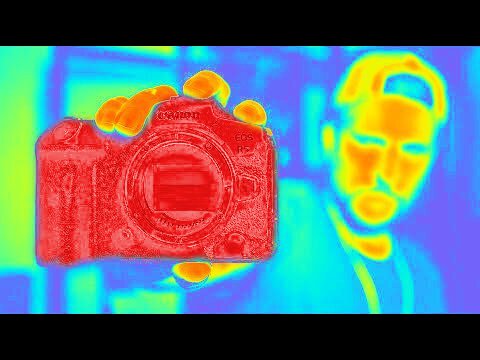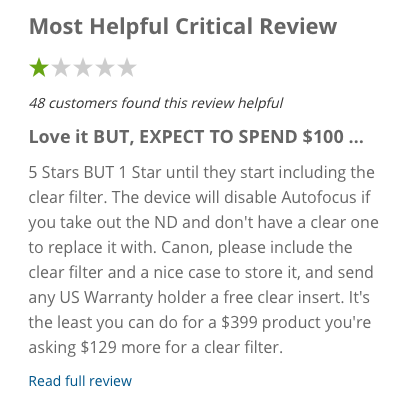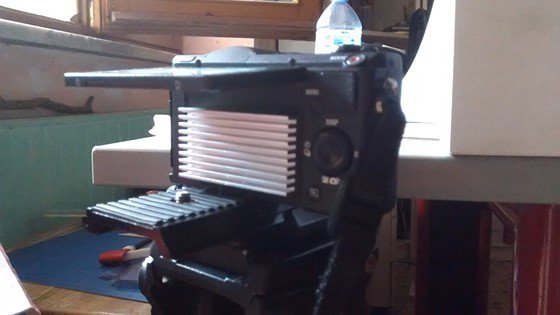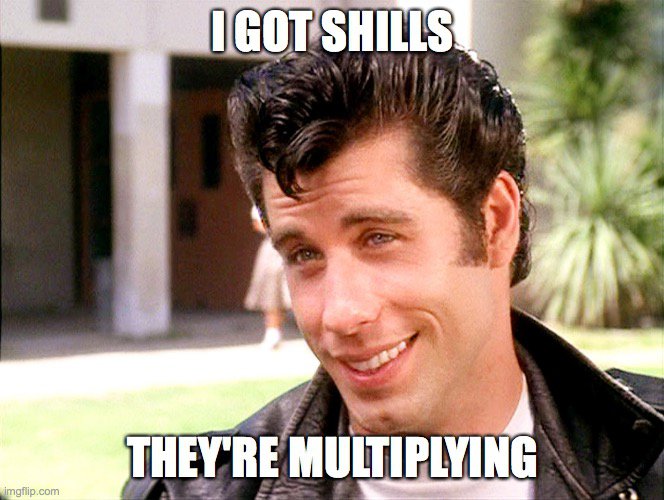-
Posts
5,964 -
Joined
-
Last visited
Content Type
Profiles
Forums
Articles
Everything posted by BTM_Pix
-
I think YouTube camera review videos shot on unusual cameras would be good. Like an R5 review shot on a thermal imaging camera for example.
-
Should be easy for someone to make a non tape based solution then to plug the hole. Although.... Maybe someone enterprising could incorporate an exhaust fan into that slot for the R5 users 😉
-
Thats good to know. The AF bit, not the dust bit. Not sure why BH don't address that on the "most helpful" bad review of it on their site !
-
I understand it disables the AF if you don't have either filter in. I'm guessing its microswitches inside the host adapter that are pressed when you slide them in so the camera knows you have inserted one or the other. So if its just physical then someone could make an empty 3D printable version of the holder to trick it.
-
Its still coming along. Or should I say they are coming along as there will now likely be two different options. I'll endeavour to show something of each of them in the next two weeks and the plan is currently to open pre-orders for them at the end of August for at least one of them. Component supply for prototyping has been a major issue as the design has been changing. Dual and offset is certainly doable but outside of the initial scope.
-
Well I suppose its all relative compared to what sort of tripod head you are using to do the tests now. Whatever the turntable or dolly are bringing to the party negatively, it is at least 100% repeatable and measurable so you can build it in. The turntables are gear driven which gives less variation than a belt driven one and the dolly can be run on a thin rubber mat to absorb the bumps. If you do have a slider then as long as you have some vertical drop space (i.e. put it on a tripod) then you could use a weight attached to a string one end of the carriage to pull it as it falls. A water bottle would do the trick as the weight as you could regulate the speed by how much water you put in. Nothing is going to be ideal unfortunately unless you want to throw a lot more money at it so you'd have to consider how much of a marginal gain any of it will bring you in terms of this project and whether thats worth it. Its all money you could be spending on buying a used EPIC and Motion Mount instead 😉
-
The turntable or the dolly ?
-
For a sub £20 budget option, there are plenty of battery operated product display turntables available on Amazon that you can just plonk the camera down in the centre of and will do the job for repeatable panning. If you want something a bit more elaborate and don't mind spending the extra £40-50 then Neewer and Andoer make very neat little motorised dollies. Their wheels can be set straight to do linear movements or angled to do inward or outward pans. They have different speed settings so you have a very repeatable may to monitor the impact the movement speed has on your tests and are operated by remote control. The upside is that aside from using it for your test you will also then have a film making tool that is a bit more creative than a turntable and can be put in your pocket and taken on holiday to up those production values !
-
I always found it an interesting example of the reality gap between what everyone says they need, in this case global shutter, and how many people actually then buy it. You don't exactly see a lot of them about.
-
While you are down this rabbit hole, you might want to take a look at the RED Motion Mount that they did for the EPIC. http://docs.red.com/955-0013/REDMOTIONMOUNTOperationGuide/Content/1_MM_Intro/1_Intro.htm As well as doing vari ND, it had a few tricks including simulating soft shutter and square shutter. There are links within that page to other explanatory documents about the process. What may be of use to you are the videos of it in action such as this one as its a unique reference really to how the look of the same camera can be changed with these simulations.
-

Canon EOS R5 has serious overheating issues – in both 4K and 8K
BTM_Pix replied to Andrew Reid's topic in Cameras
What has that got to do with what I said ? -

Canon EOS R5 has serious overheating issues – in both 4K and 8K
BTM_Pix replied to Andrew Reid's topic in Cameras
Yes, I know. The broader point was that wherever that heat was coming from, Sigma had a strategy front and centre in the design to deal with it. Their initial presentation of the fp made as much if not more of an issue about it as they did about any other individual feature of the camera. It doesn't make Sigma any more right or wrong than Canon, just that they placed much more emphasis on it as an integral aspect of the design. Which left them no time to do any AF 😉 -

Canon EOS R5 has serious overheating issues – in both 4K and 8K
BTM_Pix replied to Andrew Reid's topic in Cameras
Sigma designed a heatsink and attached a camera to it. Seems they had some sort of intuition that full frame cameras in small bodies might run a bit on the warm side. Considering the gulf in price between the R5 and the nearest camera with a comparable spec, I'm sure some enterprising company could make some money rehousing them into more cinema camera style bodies with a proper cooling system. If this thing was £2K dearer and didn't overheat then I'm sure no one who wanted 8K RAW would baulk at that price. People have been cinevising stills lenses for years so maybe its time to do the same with bodies. -
If your camera has PDAF then there aren't any. If it doesn't, then it can be faster than what you do have. The real benefit is in when you camera has absolutely no AF of its own.... But its not all sweetness and light.
-

Canon EOS R5 has serious overheating issues – in both 4K and 8K
BTM_Pix replied to Andrew Reid's topic in Cameras
Yeah, maybe they should have approached Sigma and swapped some AF tech for some cooling tech ! I think there could have been an opportunity for them to do something creative with a battery grip style accessory that mounted underneath the camera. Something like a removable/sliding section on the camera bottom plate which the cooling elements and fan in the base unit could then utilise to get at the internals whilst still sealing them to the outside world. That would suit both sides of the argument by not having to have something elaborate internally which many people might not need but also offering a factory solution for those who do want to use the more flammable features of the camera. -

Canon EOS R5 has serious overheating issues – in both 4K and 8K
BTM_Pix replied to Andrew Reid's topic in Cameras
I'll be sitting this one out as I've no intention of spending £4K on anything that doesn't have an engine or four wheels for a goodly long time. There have been a number of people in the past that have used removable heat sinks on the rear of their (usually Sony) camera for those with tiltable screens such as this Something like that may help, not least because you've also removed the contact of the screen to the main body and I suspect running it on external power instead of the internal battery won't do it any harm either. But all of these sorts of solutions remind me very much of the payoff line at the end of a famous UK public information film from when I was a kid on how to mobilise the family to deal with a burst water pipe. -

Canon EOS R5 has serious overheating issues – in both 4K and 8K
BTM_Pix replied to Andrew Reid's topic in Cameras
Sounds like this camera would turn them into an omelette if they did. -
If you have Handbrake you can just do a quick transcode into something you know your computer deals with OK. Bizzarely enough, as it Vimeo is usually terrible for me, it streams OK for me. This test by Ed David is going for a similar (minus film) comparison about motion cadence amongst other things so might be worth a look for you
-
Is this in Vimeo or did you download the file ?
-
This is what I've gleaned on the issue over the years... To test motion cadence effectively you need to mount the two cameras on a dual mount tripod bar and ensure you have ,if not the same lens, at least the same focal length one on each. For a test subject, you need something that can move of its own accord so you will see motion within a static framing but also that has enough movement to exit the frame so you can pan to track it and see the effects on a moving framing. The ideal subject for this when it comes to testing motion cadence is, by common consent, a unicorn. The ideal speed for the unicorn to be moving is from a slow walk up to a gentle trot. Most unicorns are lazy but skittish, so a few party poppers will enable you to encourage this range of movement. On the camera itself, make sure that the power draw isn't effecting motion cadence by using a fully charged battery and that you have mojo set to 10 or boost if your camera has it. Depending on the brand of camera that you are using, you should also ensure that you have fully topped up your Koolaid levels. 😉 On a more serious note, this is a decent thread with some informed discussion about it and also contains a link to a side by side video between real film, Alexa, Red and the Sony F65. https://cml.news/g/cml-raw-log-hdr/topic/16427778?p=Created,,,20,1,0,0::recentpostdate%2Fsticky,,,20,2,0,16427778
-
Have you tried your Hasselblad HC lenses on it or did you not get the adapter in the end ?
-
Did you offer them a fair price for those other lenses on that counter 😉
-
I think expansion of the L mount alliance is more a question for Leica as they are the gatekeepers as far as I understand.
-

Canon 9th July "Reimagine" event for EOS R5 and R6 unveiling
BTM_Pix replied to Andrew Reid's topic in Cameras
Hopefully they've all had the cameras long enough to have done something a bit more in depth with them because with Canon seemingly going so far against type and piling the spec on, there may be a lot of devil in the detail with regards to potential caveats in the different modes. Big day for Canon fans though. And fans of shock faced based thumbnails. -

Canon 9th July "Reimagine" event for EOS R5 and R6 unveiling
BTM_Pix replied to Andrew Reid's topic in Cameras
I have noticed actually that after ages of Squarespace, WIX and Monday.com plaguing me with ads on YouTube that most of mine in the past month have been from Canon so maybe they are really embracing marketing through the "Yo guys, smash the like button" avenue. To paraphrase Travolta, tomorrow might be a case of this.








